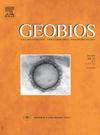First evidence of ichnopathologies in Rhinoceripeda tasnadyi tracks from the Miocene of Hungary
IF 1.6
4区 地球科学
Q2 PALEONTOLOGY
引用次数: 0
Abstract
Despite a vast record, ichnological evidence of malformed or injured animals is extremely rare. During the re-examination of slabs collected from the Ipolytarnóc tracksite (Early Miocene, North Hungary) and housed at the Supervisory Authority for Regulatory Affairs, three “atypical” tracks were detected along the same trackway. They belong to the ichnotaxon Rhinoceripeda tasnadyi, attributed to a medium- to large-sized “hornless” Miocene rhinocerotids. The hoof of the left digit III appears to be split, rather than oval, at approximatively half of its width, giving an almost tetradactyl appearance to the footprints. The deformation due to overprinting is excluded because of the number of tracks showing the same variation. This injury/malformation could be identified as the atypical tracks belong to a trackway where the opposite impression is preserved and due to the large number of accessible R. tasnadyi footprints. These account for a wide range of the standard variability of the morphology at Ipolytarnóc. If the track record was limited, or when the atypical tracks do not belong to a trackway, it would not be possible to recognise those differences as ichnopathologies and, as a result, a different trackmaker would have been assessed, or a wrong ichnotaxonomical diagnosis would have been attributed.
在匈牙利中新世发现的塔斯纳迪鼻尖足动物足迹中发现的第一个技术病理学证据
尽管有大量的记录,但畸形或受伤动物的技术证据极其罕见。在重新检查从Ipolytarnóc轨道站点(早中新世,北匈牙利)收集的石板并保存在监管事务监管机构时,在同一轨道上发现了三条“非典型”轨道。它们属于一种中、大型的中新世“无角”犀类。左指III的蹄子似乎是分裂的,而不是椭圆形的,大约是其宽度的一半,给脚印一个几乎四足的外观。不包括套印引起的变形,因为显示相同变化的轨道数。这种损伤/畸形可以确定为非典型足迹属于一个相反的印痕被保留的足迹,并且由于大量可接近的R. tasnadyi脚印。这些解释了在Ipolytarnóc上广泛的标准形态变化。如果轨迹记录有限,或者当非典型轨迹不属于轨迹时,就不可能将这些差异识别为技术病理学,因此,可能会评估不同的轨迹制造者,或者可能会归因于错误的技术分类诊断。
本文章由计算机程序翻译,如有差异,请以英文原文为准。
求助全文
约1分钟内获得全文
求助全文
来源期刊

Geobios
地学-古生物学
CiteScore
3.30
自引率
6.20%
发文量
28
审稿时长
6-12 weeks
期刊介绍:
Geobios publishes bimonthly in English original peer-reviewed articles of international interest in any area of paleontology, paleobiology, paleoecology, paleobiogeography, (bio)stratigraphy and biogeochemistry. All taxonomic groups are treated, including microfossils, invertebrates, plants, vertebrates and ichnofossils.
Geobios welcomes descriptive papers based on original material (e.g. large Systematic Paleontology works), as well as more analytically and/or methodologically oriented papers, provided they offer strong and significant biochronological/biostratigraphical, paleobiogeographical, paleobiological and/or phylogenetic new insights and perspectices. A high priority level is given to synchronic and/or diachronic studies based on multi- or inter-disciplinary approaches mixing various fields of Earth and Life Sciences. Works based on extant data are also considered, provided they offer significant insights into geological-time studies.
 求助内容:
求助内容: 应助结果提醒方式:
应助结果提醒方式:


